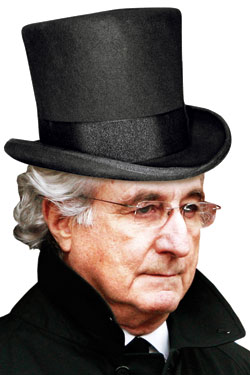
In the beginning, barely six months ago, it all seemed fairly clear. There was Bernard Madoff, an epic villain who had operated the biggest Ponzi scheme in history, and there were his victims: those who had trusted him with their life savings, only to be betrayed.
Now doubt has set in. Leaving aside the question of whether his wife and sons, and those who worked around him for decades, must have known something was wrong, there is the awkward problem of whether the clients, who were willing to accept those juicy investment returns in the first place, were culpable, too. What were they thinking? Doesn’t everyone know you do not get so much so consistently for so long unless something is wrong?
For some of them, the answer is yes. After sorting through piles of paper and microfiche files (Madoff did not like computers), Irving Picard, the court-appointed bankruptcy trustee in the Madoff case, announced last week that he was trying to reclaim $10 billion from investors and money managers who either should have or did know Madoff was not all that he seemed. He filed suit against Jeffry Picower, a New York investor, seeking the return of $5.1 billion, and $1.1 billion from Harley International, a Cayman Islands hedge fund.
As the suit against Picower and his wife, Barbara, puts it: “Defendants knew or should have known that they were profiting from fraud because of the implausibly high rates of return that their accounts supposedly achieved.” Picower, who denies any wrongdoing, placed money with Madoff for twenty years and achieved a ripe annual return of 22 percent from 1996 to 2007—enabling him to withdraw $5.1 billion more than he deposited.
This is to be expected. Ponzi schemes need to offer high returns—better than well-known banks or money managers—in order to lure enough money to keep the pyramid going. The longer a Ponzi scheme lasts (and Madoff’s lasted for nearly five decades), the less plausible it becomes. Such schemes depend on the fraudster’s gathering around him a circle, or multiple circles, of people who have invested their own money and have an incentive to disregard any warning signs. They are needed to bring in new money so they can take their own winnings out. Ponzi schemes do not just feature fraudsters and victims who are entirely innocent. There are also passive accomplices who assist the fraud, people who know that something is wrong but are lulled by self-interest into doing nothing.
The similarity between Madoff and Merdle, the fraudulent Victorian banker in Charles Dickens’s Little Dorrit, the BBC adaptation of which played recently on Masterpiece Theatre, has been noted. But the parallel extends to the dupes and hangers-on who press Merdle to take their money.
William Dorrit offers Merdle his fortune and is rewarded with a ride in the fraudster’s carriage, from which he can see “the general bowing and crouching before this wonderful mortal.” From then on, “the name of Dorrit was always a passport to the great presence of Merdle.”
So what is Dorrit? A victim (he loses all of his money to Merdle) or an accomplice (he introduces others to the fraud)? A similar ambiguity applies to some of those around Madoff. These modern William Dorrits, those closest to the “greatest Forger and greatest Thief that ever cheated the gallows,” are scrambling to defend themselves and to declare that they knew as little as anyone about the laconic sociopath. In 21st-century New York, as in Victorian London, that can be a tough story to sell.
Gapper is a columnist for the Financial Times.
Have good intel? Send tips to intel@nymag.com.